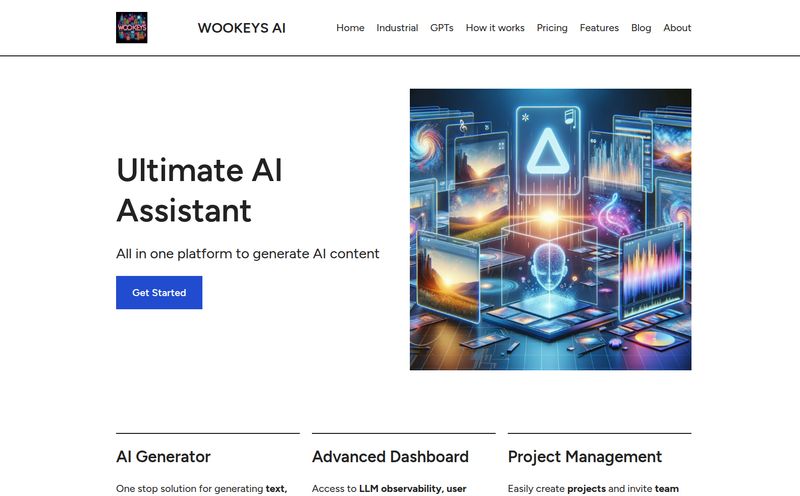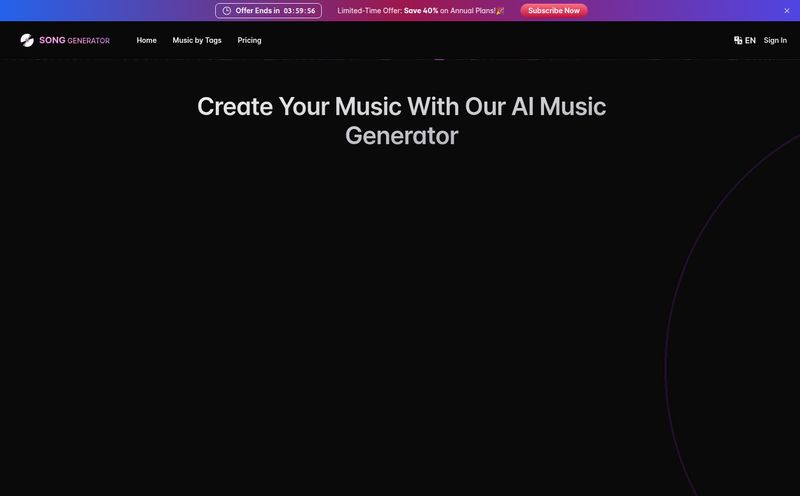Remember making mixtapes? I’m talking about the real deal. Cassettes. Spending hours hunched over a dual-deck, hitting record and pause at just the right moment. The sheer agony of messing up the last song. Then came CD burning, and then the endless, sterile world of digital playlists. Something got lost along the way, didn’t it? The personality. The story.
I've always felt that modern playlists, even the algorithmically “perfect” ones from Spotify, lack a certain soul. They're good at giving me more of what I already know, but they rarely surprise me. They don't understand vibes.
Well, I recently stumbled upon a tool that brought back a little of that old mixtape magic, and I just have to tell you about it. It's called Natural Language Playlist, and it's kind of like having a conversation with a super-knowledgeable, slightly eccentric record store clerk.
So, What Exactly Is This Thing?
Put simply, Natural Language Playlist is an AI-powered mixtape generator. But that description feels a bit cold for what it actually does. You don't just type in “80s rock.” Instead, you give it a whole sentence, a feeling, a scenario. You give it a piece of your imagination, and it gives you a soundtrack in return.
It works by taking your prompt—your weird, wonderful, hyper-specific request—and scanning a massive dataset of song metadata to find tracks that fit the musical and cultural feeling you're going for. It's less of a search engine and more of a musical interpreter. And honestly, it’s a blast to play with.

Visit Natural Language Playlist
A Music Dork's Dream Project
One of the things that immediately drew me to this tool is that it isn’t some faceless product from a giant tech corp. It was created by Abelardo Riojas, who describes himself as a 23-year-old Data Science grad student and “music dork.” You can just feel the passion behind it. According to the site's 'About' page, he spent his teens on music forums, just soaking up the culture. This project is his exploration of the connection between language, music, and culture.
It’s a tool made for music lovers, by a music lover. And in an internet that feels increasingly sanitized and corporate, that’s a breath of fresh air. It feels personal, and that makes me want to root for it, you know?
How to Speak the AI's Language for the Best Mixtapes
Okay, so you're ready to make a playlist. You open up the site, and you're staring at a blank text box. What now? Talking to an AI can be a little weird at first. Luckily, after some trial and error (and reading the creator's own tips), I’ve figured out a few things. This isn't Google; you have to be a bit of a poet.
Get Poetic, Not Just Precise
This is the most important part. The more descriptive and evocative you are, the better the results. Don't just ask for “sad songs.” That’s too broad. Instead, try something with a story, like the site's own example: “Midwest Emo songs to cry to in a parent's old car on a long drive after a breakup with me.” See the difference? That's a whole movie scene in one sentence. The AI can latch onto words like “Midwest Emo,” “cry,” “old car,” and “breakup” to build a much more specific and interesting playlist. It's about painting a picture with your words.
It's an Optimist, So Avoid the 'Not's
This is a fun little quirk. The model struggles with negative commands. So, if you type in “rock songs that are not loud,” you might just get... well, loud rock songs. It’s a common thing with this kind of AI. Instead of telling it what you don't want, focus on what you do want. A better prompt would be “quiet, acoustic rock songs” or “mellow rock for a rainy afternoon.” It forces you to be a little more creative with your language, which I kinda like.
Focus on the Vibe, Not Just the Names
While you might be tempted to ask for a playlist that “sounds like The Killers,” you'll probably get better results by describing the feeling of their music. Why do you like them? Is it the soaring choruses? The driving basslines? The early 2000s indie rock energy? Try a prompt like: “Very danceable, melodic house, fast tempo, ‘for her’ pop songs for lovers.” This gives the AI way more to work with than just a single artist's name, whose metadata might not even be perfectly categorized. Think in adjectives, moods, and textures.
My Own Test Drive: A Journey into the AI's Mind
Of course, I had to take it for a spin myself. I've been on a big ambient kick lately for late-night work sessions. So I gave it this prompt: “Music for a quiet city night seen from a high-rise apartment. Something contemplative, a little melancholic, but with a spark of hope. Like Blade Runner but less dystopian.”
The results? Fascinating. It spit out a list of about 15 songs. A few were spot on—some beautiful, atmospheric tracks from artists I'd never heard of. One was a track by an obscure Japanese electronic artist that perfectly captured that “spark of hope” I asked for. A couple were a little off the mark, maybe a bit too energetic. And one was a complete head-scratcher, an indie folk song that didn't seem to fit at all.
But that’s part of the charm! It’s not perfect. It's an adventure. It served me some genuine gems I've since added to my regular rotation, and it did it based on a weird, cinematic prompt I just came up with. I'd call that a success.
The Advantages and Disadvantages
After playing around with it for a while, I've got a pretty good handle on its strong points and where it still has room to grow. The biggest advantage is obviously the unique music discovery. This isn't just an algorithm feeding you what it thinks you'll like based on your listening history. It’s a tool for active exploration. You can stumble upon entire subgenres and artists that would never have crossed your path otherwise. It's easy to use and genuinely fun.
On the other hand, its main weakness is its reliance on the AI's interpretation. Sometimes it just... gets it wrong. A complex prompt or a niche cultural reference might fly right over its digital head. And as we discussed, asking for specific artists is a bit of a gamble. It's a tool that requires a bit of finesse and patience from the user.
What's the Catch? The Price of Admission
This is usually the part of the review where I talk about pricing tiers and subscriptions. But here's the best part: Natural Language Playlist is free. It's a passion project, remember? You can log in with your Spotify account to save the playlists or just use it as a guest. There are no hidden fees or premium versions.
This also means it's a work in progress. For instance, there's a link on the site for independent artists who want to get their music added. When I tried clicking it, I got a “404 Not Found” error. To me, that's not a flaw—it's a sign of authenticity. It’s a real person's project, not a perfectly polished product, and that makes it all the more endearing.
Frequently Asked Questions
How does Natural Language Playlist actually work?
It uses a form of Artificial Intelligence called Natural Language Processing (NLP). The creator, Abelardo Riojas, curated a large dataset of textual metadata about songs—things like genre tags, lyrical themes, and cultural descriptions. When you type in a prompt, the AI analyzes your words and matches them to the descriptions in its dataset to build a list of relevant songs.
Is Natural Language Playlist a free tool?
Yes, as of right now, it is completely free to use. You can generate playlists as a guest or log in with your Spotify account to save them directly to your library. There's no cost involved.
Can I add my own music to the platform?
The creator included a link for independent artists to submit their music for consideration. However, that link appears to be broken at the moment. It's a great idea, and hopefully, it gets fixed in the future, as it would make the tool even more powerful for music discovery.
Why shouldn't I use specific artist names in my prompts?
While you can try, it’s not the most effective way to use the tool. The AI works best with descriptive language about moods, genres, and feelings. It's designed to understand “vibe” more than it is to recognize every single artist name. You’ll get much more interesting and accurate results by describing the kind of music you want.
What's the best way to write a prompt for this AI?
Be creative and specific! Paint a picture. Instead of “workout music,” try “high-energy 90s hip hop for lifting heavy weights.” Instead of “chill music,” try “songs for a lazy Sunday morning with a cup of coffee.” The more detail and atmosphere you provide, the better.
Final Thoughts
In a world of predictable algorithms, Natural Language Playlist is a delightful anomaly. It’s not perfect, and it might not replace your Discover Weekly, but that’s not the point. It’s a playground for the musically curious. It’s a tool that encourages creativity and rewards you with genuine, surprising discoveries.
It brings back a little of that chaotic, personal magic of the old mixtape. You’re not just pressing play; you’re a collaborator. You’re telling the story, and the AI is finding the soundtrack. And for any true music lover, that’s an exciting prospect indeed. Go give it a try—what's the worst that can happen? You might just find your new favorite song.



